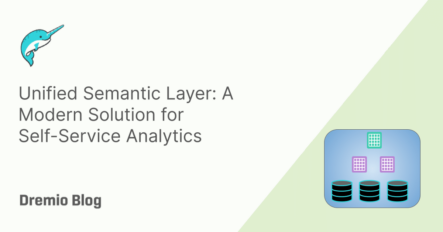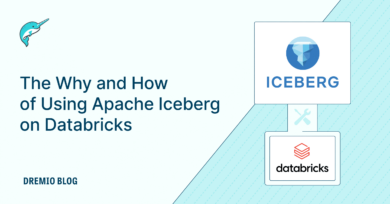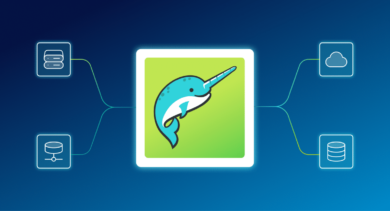10 minute read · June 25, 2024
Unified Semantic Layer: A Modern Solution for Self-Service Analytics
· Technical Evangelist, Dremio

The demand for flexible and fast data-driven decision-making is critical for modern business strategy. Semantic layers are designed to bridge the gap between complex data structures and business-friendly terminology, enabling self-service analytics. However, traditional approaches often struggle to meet performance and flexibility demands for today’s business insights. This is where a data lakehouse-powered semantic layer provides a transformative solution, offering a comprehensive and scalable platform that unlocks benefits for both data teams and business users.
What Is a Semantic Layer?
A semantic layer is a business representation of corporate data that helps end users access data autonomously using common business terms. It acts as an abstraction layer between the underlying data storage and the BI tools used for analysis.
Key characteristics of a semantic layer:
- Business-friendly vocabulary: It translates technical data elements (columns, tables, etc.) into familiar business concepts (revenue, customer, product). This enables users to interact with data using language they understand, without needing to know SQL or the underlying data structures.
- Abstraction of complexity: It hides the complexity of the physical data model, including data sources, schemas, and relationships, from end users. This simplifies data exploration and analysis, making it accessible to a wider audience.
- Centralized business logic: It encapsulates common business logic, calculations, and metrics, ensuring consistency and accuracy across different analyses and reports. This eliminates the need for users to repeatedly define the same calculations, saving time and reducing the risk of errors.
- Access control and security: It enforces data security and governance policies, ensuring that users can only access the data they are authorized to see. This protects sensitive data and ensures compliance with regulations.
- Performance optimization: Some semantic layers include query acceleration techniques, like Dremio's reflections, to optimize query performance on large datasets. This enables users to get the insights they need quickly, even when working with massive amounts of data.
Why semantic layers are important:
- Self-service analytics: Empowers business users to access and analyze data independently, without relying on IT or data experts.
- Improved decision-making: Provides a common understanding of data across the organization, leading to better collaboration and more informed decision-making.
- Increased productivity: Streamlines data access and analysis, reducing the time and effort required to generate insights.
- Reduced errors: Centralizes business logic and calculations, minimizing the risk of errors and ensuring consistency in reporting.
- Improved data governance: Enforces data security policies and provides a clear audit trail of data access and usage.
Traditional Semantic Layers: Bottlenecks to Business
Traditional semantic layers, commonly built on top of data warehouses or data marts, face several challenges that slow business insights:
- Performance bottlenecks: Aggregating and transforming data within the semantic layer can significantly impact query performance, leading to delays in generating insights, especially when dealing with large volumes or complex queries. This is particularly impactful in scenarios where real-time decision-making is critical (i.e., fraud detection, inventory management, etc.).
- Limited flexibility: The semantic layer’s origins lie in OLAP. These layers rely on pre-defined data models and cubes, restricting the ability to adapt to evolving business requirements or explore new avenues of analysis. Introducing new metrics or dimensions often requires time-consuming development cycles across multiple teams.
- Data duplication and silos: The reliance on data extracts and materialized views in traditional semantic layers leads to data redundancy and potential inconsistencies. This not only increases storage costs but also raises concerns about data accuracy and governance.
- Restricted self-service: Users may still need to understand the underlying data structures or rely on IT for data access, limiting their ability to perform truly self-service analytics. This reliance on technical expertise hinders collaboration and slows down the decision-making process.
A Modern Approach to Unified Semantic Layers
A data lakehouse-powered semantic layer provides a modern alternative that addresses these limitations. This approach leverages the strengths of both data lakehouses and semantic layers to create a unified, scalable, and high-performance platform.
Key components:
- Unified data storage: Data lakehouses centralize diverse data types (structured, semi-structured, unstructured) in a single repository, eliminating data silos and simplifying data access for the semantic layer. This eliminates the need to move or copy data, ensuring that the semantic layer operates on the most up-to-date and complete dataset.
- Metadata management: A robust metadata layer captures and defines the relationships between data entities, business terms, and technical definitions. This metadata is the foundation of the semantic layer, enabling users to interact with data in a business-friendly manner.
- Business logic abstraction: The semantic layer abstracts complex data transformations and calculations, making them accessible to business users through familiar terms and concepts. This empowers users to create reports, dashboards, and visualizations without needing to understand SQL or the underlying data structures.
- Query optimization: Data lakehouses leverage advanced query engines, such as Dremio's reflections technology, which automatically optimizes query execution through materialized views and intelligent caching. This delivers interactive performance even on large datasets, enabling users to explore data in real time.
Business Benefits of a Data Lakehouse-Powered Semantic Layer
Unified data lakehouse semantic layers unlock a range of business benefits:
- Accelerated time to insight: Advanced query optimization delivers near real-time results, enabling faster and more informed decision-making.
- Enhanced data freshness: Direct access to data in the data lakehouse ensures that insights are always based on the latest information.
- Improved collaboration: The semantic layer fosters a common understanding of data across the organization, promoting collaboration between data teams and business users.
- Increased agility and flexibility: The flexible schema and data models of a data lakehouse allow for rapid adaptation to evolving business requirements and exploration of new data relationships.
- Empowered self-service analytics: Business users can explore and analyze data independently, using familiar business terms, without relying on IT.
- Cost savings: Reducing data duplication and streamlining data pipelines can lead to significant cost savings in storage and infrastructure.
Summary
Building a semantic layer on a data lakehouse represents a significant evolution in business intelligence. Providing a unified, high-performance platform for data access, transformation, and analysis empowers organizations with the speed, agility, and collaboration needed to thrive in the modern business era.
Additional Resources
- Get started with Dremio
- The Unified Apache Iceberg Lakehouse: Unified Analytics
- The Value of Dremio’s Semantic Layer and the Apache Iceberg Lakehouse to the Snowflake User
- The Unified Apache Iceberg Lakehouse: Unified Analytics
- How to Use Dremio’s Reflections to Reduce Your Snowflake Costs Within 60 Minutes


